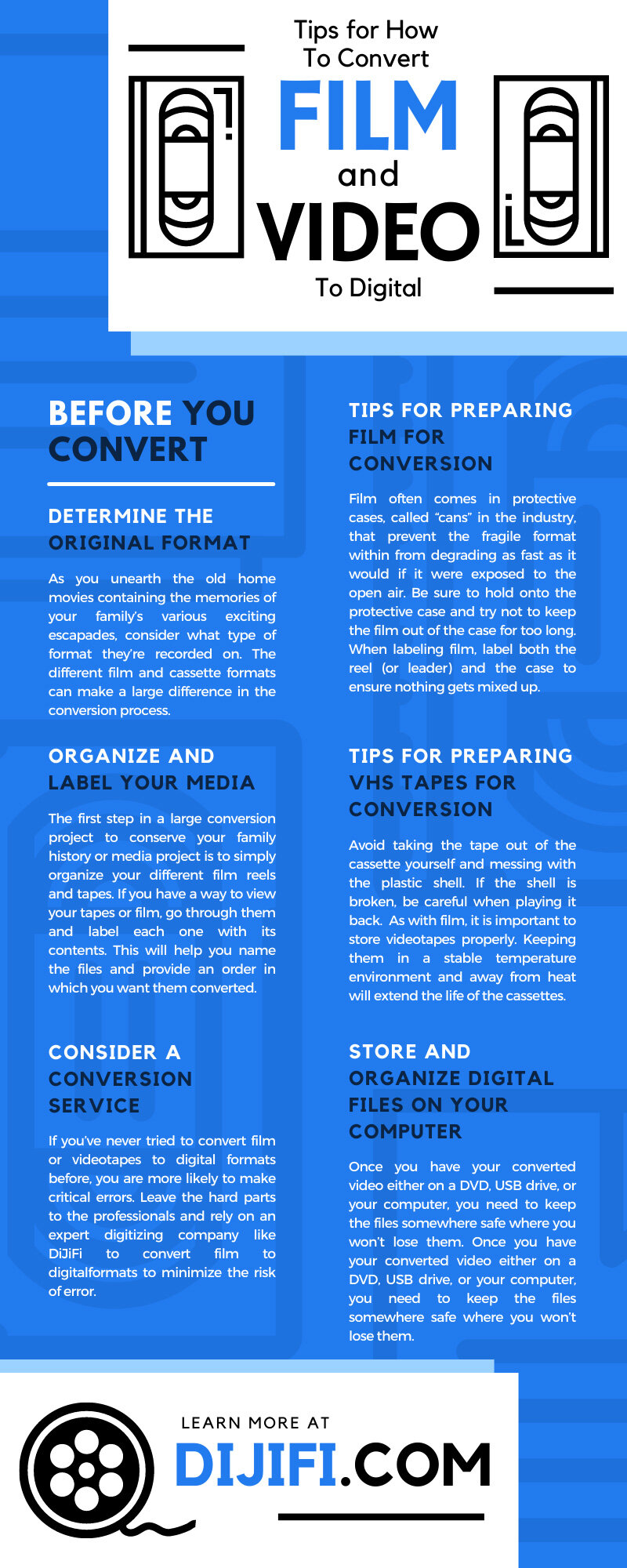Tips for How To Convert Film and Video To Digital
If you have a large collection of home videos and film recorded on outdated media formats and nowhere to watch them, consider transferring them to a more modern format. Though the process requires some extra work on your end to make everything go smoothly, you’ll have a more modern way to share those decade-old videos and film with close friends and family once they’re finished. Since they’re an important part of your family history, it’s necessary for you to treat your old video and film formats with care and follow these tips for how to convert film and video to digital, or you may risk destroying the media during the process.
Before You Convert
While you may just want to jump directly into converting your old film and videos to a more modern format, it’s important to understand that it’s not a process to take lightly. Plenty of mistakes can happen that will destroy or damage your media before you even begin the conversion process. Take the project seriously and ensure that you prepare properly for any film or video conversion with the following tips:
Determine the Original Format
As you unearth the old home movies containing the memories of your family’s various exciting escapades, consider what type of format they’re recorded on. The different film and cassette formats can make a large difference in the conversion process. Not every reel of film or tape allows you to convert them the same way—separate any film formats that are different from each other and never try to splice or combine the original formats yourself.
Once they’re digitized, you can mess around with the movies on a computer to put them together in a coherent manner, but you should never combine film or tape until they’re in the same format. Learn about the different types of film and video formats you can transfer to digital and what they look like before beginning your project.
Organize and Label Your Media
The first step in a large conversion project to conserve your family history or media project is to simply organize your different film reels and tapes. As mentioned before, you must organize them by media type—but you should go deeper with your organization method to speed up the conversion process.
If you have a way to view your tapes or film, go through them and label each one with its contents. This will help you name the files and provide an order in which you want them converted. Videotape players are still relatively common, but if your household lacks one, you may be able to find one used in your resale marketplace of choice. Before you place your precious tapes in a playback device, use a tape you care less about to test the device and check quality. A dirty VCR player can cause a fuzzy image on the TV—just make sure that it’s not a problem related to the TV itself!
You may have more difficulty finding an affordable projector to play your older film formats back. If you can’t organize and label the film reels as they are, you may need to hold off on organizing them until they’re digitized.
Consider a Conversion Service
With all your old media formats organized and ready for digitization, the easiest next step would be to send the film reels and VHS tapes to a professional digitization company. If you’ve never tried to convert film or videotapes to digital formats before, you are more likely to make critical errors. Leave the hard parts to the professionals and rely on an expert digitizing company like DiJiFi to convert film to digital formats to minimize the risk of error.
Tips for Preparing Film for Conversion
Film often comes in protective cases, called “cans” in the industry, that prevent the fragile format within from degrading as fast as it would if it were exposed to the open air. Be sure to hold onto the protective case and try not to keep the film out of the case for too long. When labeling film, label both the reel (or leader) and the case to ensure nothing gets mixed up.
Tips for Preparing VHS Tapes for Conversion
Videotapes are far sturdier than film reels; however, they don’t come without their own set of worries. Avoid taking the tape out of the cassette yourself and messing with the plastic shell. If the shell is broken, be careful when playing it back. As with film, it is important to store videotapes properly. Keeping them in a stable temperature environment and away from heat will extend the life of the cassettes. Never put them on top of stereo speakers which often have magnets that can impair the videotape.
Store and Organize Digital Files on Your Computer
Once you have your converted video either on a DVD, USB drive, or your computer, you need to keep the files somewhere safe where you won’t lose them. Place the videos in their own folders based on your present or future projects and make copies in case something happens to the originals—especially if you’re working on editing the videos in a video editor program. Protect your folders with passwords to keep your data safe and make sure they’re named clearly in a way that you will remember their contents.
By considering these tips for how to convert film and video to digital, you’ll ensure a proper video file that will impress everyone you share it with. Whether you want to reminisce on old family moments or want to share your independent film with the world, DiJiFi can provide you with the conversion services to fit your project’s needs.


